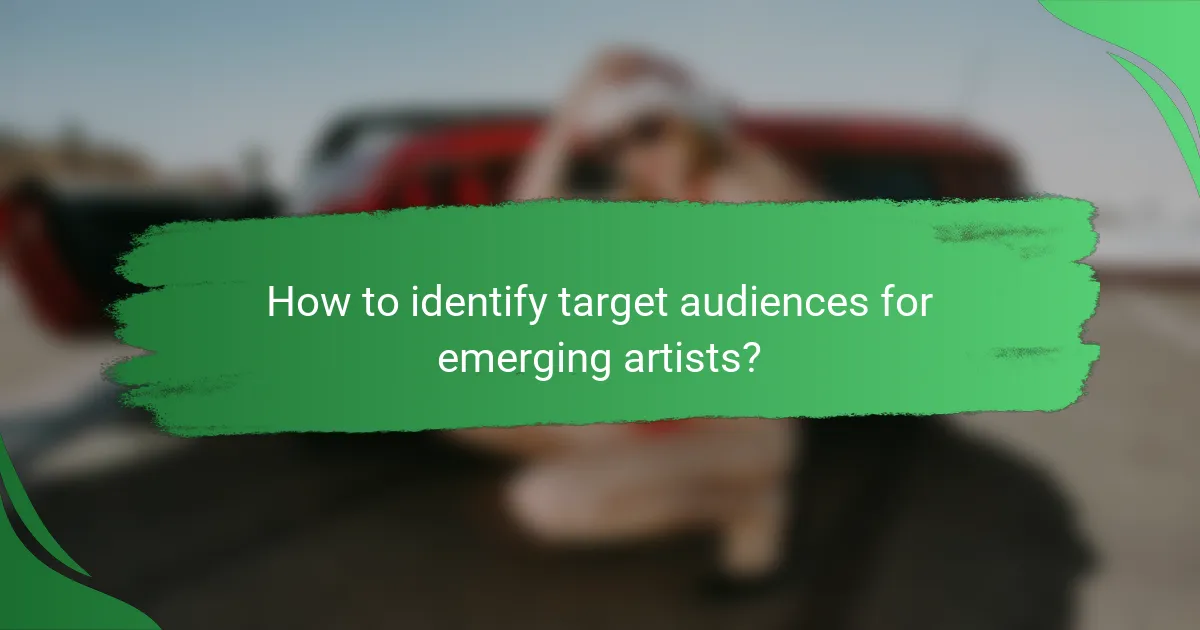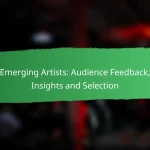Identifying target audiences for emerging artists is essential for fostering appreciation and support for their work. This involves analyzing demographic and psychographic data, as well as social media interactions, to ensure alignment with market needs and brand identity. By understanding these dynamics, artists can refine their strategies and build meaningful connections with their audience.

How to identify target audiences for emerging artists?
Identifying target audiences for emerging artists involves understanding who is most likely to appreciate and support their work. This process includes analyzing demographic data, psychographic traits, market segments, social media interactions, and insights from the art community.
Demographic analysis
Demographic analysis focuses on statistical characteristics of potential audiences, such as age, gender, income level, and education. For emerging artists, identifying the age group that aligns with their art style can be crucial; for instance, younger audiences may gravitate towards contemporary themes while older demographics might prefer traditional forms.
Consider using surveys or existing data sources to gather demographic information. This can help artists tailor their marketing strategies effectively, ensuring they reach the right people with their work.
Psychographic profiling
Psychographic profiling delves into the interests, values, and lifestyles of potential audience members. Understanding what motivates an audience can help artists create more resonant work and marketing messages. For example, an artist whose work reflects environmental themes may appeal to audiences who prioritize sustainability.
To conduct psychographic profiling, artists can engage with their audience through social media polls or interviews, gaining insights into their preferences and values.
Market segmentation
Market segmentation involves dividing the broader audience into smaller, more manageable groups based on shared characteristics. Emerging artists can segment their audiences by factors like art preferences, buying behaviors, or geographic location. This allows for targeted marketing efforts that speak directly to each segment’s interests.
For instance, an artist might find that urban dwellers are more inclined to purchase modern art, while rural audiences may prefer landscapes. Tailoring marketing strategies to these segments can enhance engagement and sales.
Social media engagement
Social media engagement is vital for emerging artists to connect with their target audiences. Platforms like Instagram and TikTok allow artists to showcase their work and interact with followers, providing valuable feedback and insights. Regularly posting content and responding to comments can help build a loyal community.
Artists should track engagement metrics such as likes, shares, and comments to understand which types of content resonate most with their audience. This data can inform future posts and marketing strategies.
Art community insights
Gaining insights from the art community can provide emerging artists with valuable information about their target audiences. Networking with other artists, attending art fairs, and participating in workshops can reveal trends and preferences within the community.
Artists should consider joining local art groups or online forums to share experiences and gather feedback. This collaborative approach can enhance their understanding of audience dynamics and improve their outreach efforts.

What selection criteria should be used for emerging artists?
When selecting emerging artists, it is crucial to consider criteria that align their artistic vision with market needs and brand identity. Key factors include artistic style alignment, market demand evaluation, and brand compatibility, each playing a significant role in ensuring successful partnerships.
Artistic style alignment
Artistic style alignment refers to how well an emerging artist’s work fits within the desired aesthetic or thematic direction of a gallery, brand, or project. This alignment can enhance the overall coherence of exhibitions or campaigns. For instance, a gallery focused on contemporary abstract art should prioritize artists whose styles reflect similar techniques and concepts.
To assess alignment, review the artist’s portfolio, paying attention to their use of color, form, and subject matter. Consider creating a checklist of key artistic elements that resonate with your vision to streamline the evaluation process.
Market demand evaluation
Market demand evaluation involves analyzing the current trends and preferences within the art market to identify which styles and themes are gaining traction. Understanding demand can help in selecting artists whose work is likely to resonate with potential buyers or audiences. For example, if mixed media art is trending, artists working in that medium may be more appealing.
Utilize tools such as art market reports, social media analytics, and gallery sales data to gauge demand. Regularly updating this information will help ensure that your selections remain relevant and commercially viable.
Brand compatibility
Brand compatibility assesses how well an emerging artist’s values, message, and style align with your organization’s identity. A strong fit can enhance brand storytelling and create authentic connections with audiences. For example, a sustainable fashion brand may seek artists who emphasize eco-friendly practices in their work.
To evaluate compatibility, consider conducting interviews or discussions with artists to understand their vision and values. Create a matrix that outlines your brand’s core principles alongside potential artists’ attributes to facilitate comparisons and decision-making.

How to leverage social media for audience alignment?
Leveraging social media for audience alignment involves understanding your target demographic and tailoring your content to meet their preferences. By analyzing engagement metrics and audience feedback, emerging artists can refine their strategies to connect more effectively with their audience.
Platform-specific strategies
Different social media platforms cater to distinct audiences and content types. For instance, Instagram is ideal for visually-driven content, making it suitable for artists to showcase their work through posts and stories. In contrast, platforms like Twitter allow for real-time engagement and discussions, which can help artists build a community around their brand.
Consider the demographics of each platform; for example, TikTok has a younger audience, while Facebook tends to attract an older demographic. Tailoring your approach based on these insights can enhance audience alignment.
Content creation tips
Creating engaging content is crucial for audience alignment on social media. Focus on high-quality visuals and authentic storytelling to resonate with your audience. Use a consistent aesthetic and voice across your posts to strengthen your brand identity.
Incorporate user-generated content and feedback to foster a sense of community. This can include reposting fan art or sharing testimonials, which not only engages your audience but also encourages further interaction.
Influencer collaborations
Collaborating with influencers can significantly boost your visibility and audience alignment. Choose influencers whose followers match your target demographic to ensure a relevant reach. This partnership can take the form of sponsored posts, joint live sessions, or even co-created content.
When selecting influencers, consider their engagement rates and authenticity. A smaller influencer with a highly engaged audience can sometimes be more effective than a larger one with lower interaction levels. Establish clear goals for the collaboration to maximize its impact on your audience alignment efforts.

What are the best practices for promoting emerging artists?
Promoting emerging artists effectively involves leveraging various platforms and strategies to reach the right audience. Key practices include forming partnerships with online galleries, hosting virtual exhibitions, and implementing targeted advertising campaigns.
Online gallery partnerships
Online gallery partnerships can significantly enhance visibility for emerging artists. Collaborating with established galleries allows artists to showcase their work to a broader audience without the overhead costs of physical spaces.
Consider selecting galleries that align with the artist’s style and target demographic. For instance, a contemporary artist might partner with a modern art gallery that attracts younger collectors. This alignment can lead to more effective promotion and sales.
Virtual exhibitions
Virtual exhibitions provide an accessible platform for showcasing art to a global audience. These online events can be organized through social media, dedicated art platforms, or the artist’s own website, allowing for interactive experiences.
When planning a virtual exhibition, ensure high-quality images and engaging descriptions of the artwork. Promote the event through social media channels and email newsletters to maximize attendance and engagement.
Targeted advertising campaigns
Targeted advertising campaigns are essential for reaching specific audiences interested in emerging art. Utilizing platforms like Facebook and Instagram allows artists to create ads that target demographics based on interests, location, and behaviors.
Set a budget that aligns with your goals, and consider starting with a small test campaign to gauge effectiveness. Monitor engagement metrics to refine your approach, focusing on ads that yield the highest interaction rates.

How to measure the success of audience alignment?
Measuring the success of audience alignment involves evaluating how well an artist’s work resonates with their target audience. Key indicators include engagement metrics, sales conversion rates, and feedback collection, each providing insights into the effectiveness of outreach and connection strategies.
Engagement metrics
Engagement metrics are vital for assessing how actively an audience interacts with an artist’s content. This can include likes, shares, comments, and time spent on platforms like social media or streaming services. A higher engagement rate often indicates a stronger connection with the audience.
To effectively measure engagement, consider tracking metrics over time to identify trends. For example, a consistent increase in comments or shares during a campaign can signal successful audience alignment. Aim for engagement rates that are above industry averages, typically around 1-3% for social media posts.
Sales conversion rates
Sales conversion rates reflect the percentage of audience members who make a purchase after engaging with an artist’s promotional efforts. This metric is crucial for understanding the financial impact of audience alignment. A higher conversion rate suggests that the audience is not only engaged but also motivated to support the artist financially.
To calculate conversion rates, divide the number of sales by the total number of audience interactions, then multiply by 100. For emerging artists, a conversion rate of 2-5% is often considered a good benchmark, depending on the type of merchandise or tickets being sold.
Feedback collection
Feedback collection is essential for gaining direct insights into audience perceptions and preferences. This can be achieved through surveys, polls, or direct communication on social media platforms. Gathering feedback helps artists understand what resonates with their audience and what areas may need improvement.
When collecting feedback, aim for a mix of qualitative and quantitative data. For instance, ask specific questions about recent releases and encourage open-ended responses for deeper insights. Regularly reviewing feedback can guide future artistic decisions and marketing strategies, ensuring alignment with audience expectations.


